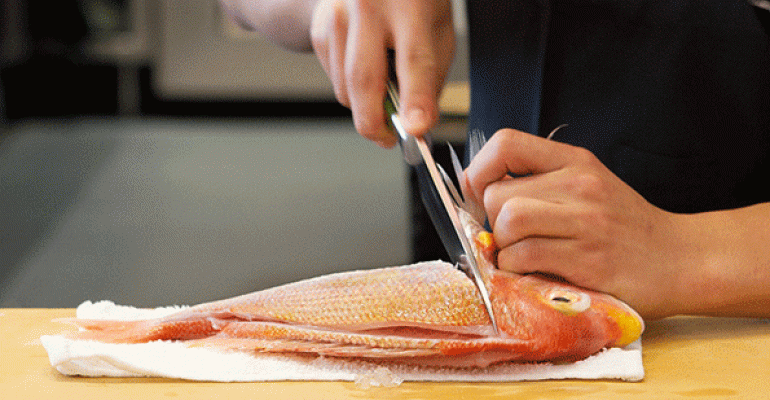It’s a widely held belief that the best fish is the freshest fish, but Mike Lim begs to differ.
The sushi chef at Roka Akor in San Francisco prefers to age much of the fish he serves.
“A lot of people misunderstand that the freshest fish is the best quality,” Lim said, adding that although that’s true for shellfish, much fin fish actually benefits from a bit of aging.
Just as steak gets more flavor and a better texture as it ages, fish also benefits from spending some time between the fishing net and the plate, he said.
Lim, who has been working with sushi for 16 years, is not talking about hanging fish for weeks at a time.
“The exact duration varies by fish, but during this time, enzymes break down in the [fish] and moisture evaporates, enabling concentration of natural flavor,” he said.
Oily fish doesn’t age well. “Oily fish will rot,” Lim said, although he does cure mackerel for a few hours to firm up the texture. He salts the fish and lets it cure on ice for two hours, and then adds some vinegar with kombu in it and some lemon and lets it cure for another two hours.
For red snapper, Lim fillets the fish, sprinkles it with salt and a 50/50 mixture of water and vinegar, vacuum-seals it in a water bath and leaves it there for three to four days, “to firm up the texture,” he said.
Maguro tuna takes seven to 10 days of aging, he said.
“Tuna is really tricky because the location [where the fish is caught] changes the quality,” Lim said.
Lim's goal with tuna is to draw out the blood so it has a consistent red texture all the way through. He wraps the loin in a “fish towel,” a paper towel made from a type of Japanese reed that absorbs moisture and oil more quickly than other towels. He wraps the fish and packs it in ice, changing the towel twice a day and cutting a circular sample out of the fish to see how the curing is progressing.
“We want the tuna to be really red all the way to the inside,” he said, without any bloody dark patches.
“Our job as chefs is to properly handle and preserve the fish during this time to allow patrons to safely consume the fish at its very best stage,” Lim said.
Contact Bret Thorn at [email protected]
Follow him on Twitter: @foodwriterdiary

